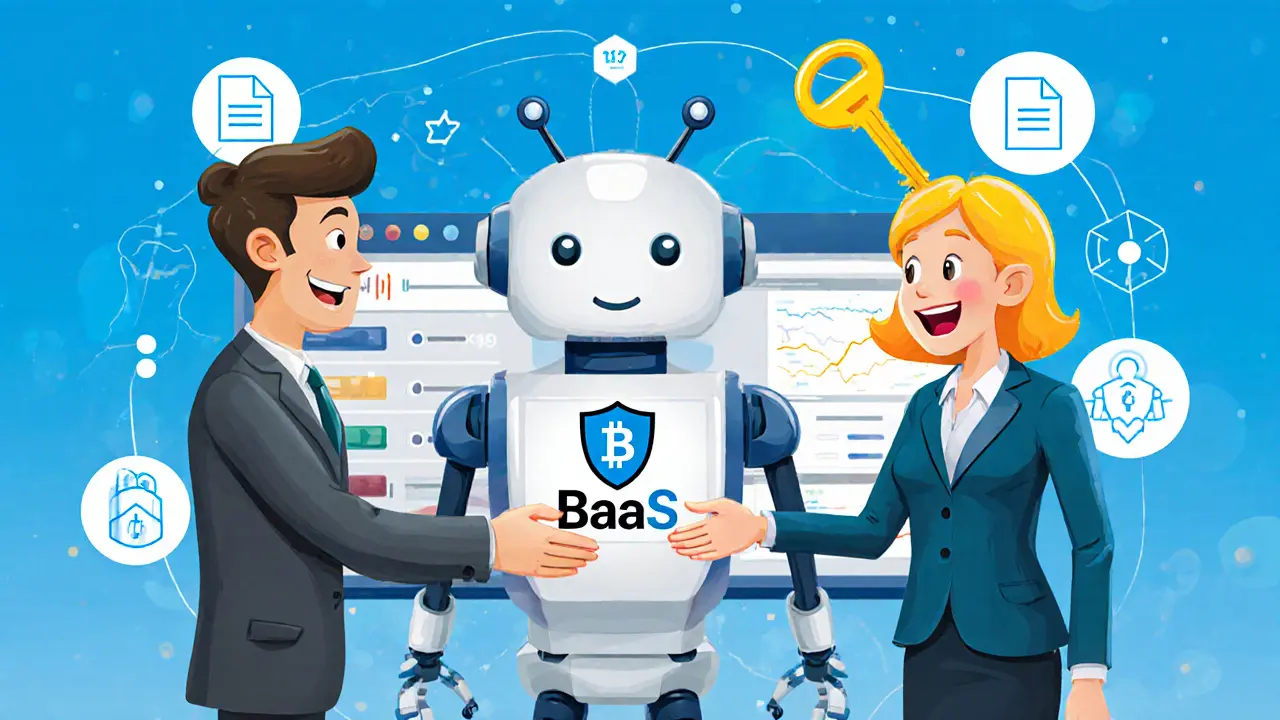
- 21 Sep 2025
- Elara Crowthorne
- 0
STRAX Staking Calculator
Staking Calculator
Calculate your potential returns from staking STRAX tokens on the Stratis platform.
Results
Most people think blockchain is all about Ethereum and Solidity. But what if you could build a blockchain using Stratis - and code it all in C#, the same language Microsoft developers use every day? That’s exactly what Stratis (STRAX) offers. It’s not just another crypto coin. It’s a full-stack blockchain platform built for businesses that already use .NET, Azure, and C#. If you’ve ever looked at blockchain and thought, “This is too complicated for my team,” Stratis might be the answer you didn’t know you needed.
How Stratis Started - From Bitcoin to Its Own Chain
Stratis wasn’t born as its own blockchain. It launched in 2016 as a Bitcoin sidechain project, built on Bitcoin’s proven codebase but with extra tools for developers. The founder, Chris Trew, wanted to make blockchain accessible to enterprise teams - especially those stuck in the Microsoft ecosystem. Back then, the native token was called STRAT. But in 2020, Stratis made a bold move: it ditched the Bitcoin foundation and launched its own independent blockchain. Along with it came a new token: STRAX.The swap was simple: every STRAT holder got one STRAX for free. No loss. No confusion. Just a clean break to give the team full control over upgrades, consensus, and scalability. This wasn’t a rebrand - it was a reset. And it worked. Today, STRAX powers a platform that’s used by banks, logistics firms, and even government agencies looking to test blockchain without hiring a team of Ethereum experts.
What Makes STRAX Different? No Solidity, No Problem
Most blockchains rely on Solidity, a language most developers learn only if they’re deep into crypto. Stratis flips that. It uses the Common Language Runtime (CLR) - the same engine behind .NET applications. That means if you know C#, you can start writing smart contracts on Stratis immediately. No new syntax. No steep learning curve. Just familiar tools.Think of it like this: if Ethereum is a foreign country where you need to learn a new language to drive, Stratis is a rental car with automatic transmission and GPS - in your native tongue. Developers don’t need to retrain. Companies don’t need to hire specialists. They just use what they already have.
This isn’t just a marketing gimmick. Stratis has real-world traction because of it. Financial institutions in Europe and North America have built internal blockchain solutions on Stratis because their IT teams already know C#. No need to outsource. No need to gamble on untested tech. Just deploy, test, and scale.
The Three Pillars of Stratis: Full Nodes, Private Chains, and BaaS
Stratis doesn’t just offer a token. It offers three core services that make it useful for real businesses:- Stratis Bitcoin Full Node: A C#-based Bitcoin node that’s faster, easier to customize, and integrates with existing enterprise systems. You get Bitcoin’s security without the complexity.
- Stratis Private Chains: Build your own private blockchain without writing a single line of low-level code. Just configure rules, permissions, and speed - then deploy. Ideal for internal audits, supply chain tracking, or secure document sharing.
- Stratis Blockchain-as-a-Service (BaaS): The most powerful offering. You get a ready-to-use blockchain environment with sidechains, APIs, and monitoring tools. No server setup. No DevOps headaches. Just a dashboard and a deploy button.
These aren’t theoretical features. A New Zealand-based logistics firm used Stratis BaaS to track high-value shipments across three countries. They cut documentation errors by 70% and reduced reconciliation time from days to minutes. They didn’t need a blockchain team. They used their existing .NET developers.

How STRAX Works: Staking, Not Mining
STRAX isn’t mined. It’s forged. That’s because Stratis uses Proof-of-Stake (PoS), not Proof-of-Work. You don’t need expensive hardware. You don’t need to burn electricity. You just hold STRAX and stake it.When you stake STRAX, you help secure the network. In return, you earn rewards - typically around 5-8% annually, depending on how many people are staking overall. The more you hold and lock up, the more you earn. It’s simple, energy-efficient, and fair.
There’s also something called a Masternode. These are special nodes that handle smart contracts and cross-chain communication. To run one, you need to hold 10,000 STRAX. In return, you get 50% of all block rewards. It’s not for casual holders - it’s for serious participants who want to help run the network.
STRAX is also used to pay for storage on the blockchain, to vote on upgrades, and to access premium features on the Stratis platform. It’s not just a speculative asset. It’s the fuel that keeps the whole system running.
Interflux Protocol: Connecting Stratis to Ethereum
One of Stratis’ smartest moves was building a bridge to Ethereum. In late 2020, they launched the Interflux Protocol. It lets you convert STRAX into wSTRAX - a wrapped version that lives on Ethereum.Why does this matter? Because now you can use STRAX in DeFi. You can lend it on Aave, trade it on Uniswap, or stake it in liquidity pools. You get the security and control of Stratis, with the liquidity and ecosystem of Ethereum. It’s a rare example of interoperability done right - not just a token bridge, but a full two-way flow.
And it doesn’t stop there. In early 2022, Stratis added support for ERC-721 - the standard for NFTs. That means you can bring your Ethereum NFTs onto Stratis and list them on Stratisphere, the platform’s own NFT marketplace. Artists, collectors, and brands can now use Stratis to tokenize assets without leaving the Ethereum ecosystem.

Where to Buy STRAX and How It’s Performing
You can buy STRAX on major exchanges like Binance, Coinbase, and Kraken. It’s also available on TradingView for charting and technical analysis. As of November 2025, the price hovers around $0.0385 USD, with a circulating supply of just over 22 million coins. The market cap is roughly $850,000 - small compared to giants like Bitcoin or Ethereum, but that’s intentional.Stratis isn’t chasing hype. It’s building for adoption. Its price doesn’t swing wildly because its value comes from real usage - not speculation. The lowest price in 2025 was $0.0337, reached in April. Since then, it’s stabilized, showing signs of steady growth as more enterprises test the platform.
Analysts give STRAX a neutral rating for the next month. That’s not because it’s weak - it’s because the project is focused on long-term enterprise adoption, not short-term price pumps.
Stratis Academy: Training the Next Generation of Blockchain Developers
Stratis doesn’t just build tech - it builds talent. The Stratis Academy offers free courses in C#, blockchain fundamentals, and smart contract development on the Stratis platform. It’s designed for developers who’ve never touched blockchain before.Over 12,000 developers from 80 countries have completed the academy’s training. Many now work at firms that use Stratis internally. The academy doesn’t push crypto. It teaches tools. That’s why it’s gaining traction in corporate IT departments, not just crypto forums.
Who Is Stratis For? And Who Should Skip It?
Stratis isn’t for everyone. Here’s who it’s perfect for:- Companies using .NET, C#, or Azure
- Teams that need a private blockchain but lack blockchain expertise
- Developers who want to enter blockchain without learning Solidity
- Enterprises looking to tokenize assets or track supply chains securely
And here’s who should look elsewhere:
- Traders chasing quick gains - STRAX moves slowly and deliberately
- Developers who only know Python or JavaScript - you’ll struggle without C# skills
- Anyone looking for a DeFi yield farm with 100% APY - Stratis offers real utility, not hype
Stratis is a quiet builder. It doesn’t tweet about moonshots. It doesn’t sponsor sports stadiums. It builds tools that solve real problems - and lets the results speak for themselves.
Is STRAX a good investment?
STRAX isn’t designed as a speculative investment. Its value comes from real usage in enterprise blockchain solutions. If you’re looking for quick profits, there are better options. But if you believe in blockchain adoption by traditional businesses - and you want to support a platform built for C# developers - then holding STRAX makes sense. Staking gives you passive income, and the platform’s growth is tied to real-world contracts, not social media trends.
Can I use STRAX in DeFi?
Yes, through the Interflux Protocol. You can swap STRAX for wSTRAX, which works on Ethereum-based DeFi platforms like Uniswap, Aave, and Compound. This gives you access to liquidity pools, lending, and yield farming - while still holding the original asset on the Stratis chain. It’s a rare bridge that works both ways.
Do I need to be a developer to use Stratis?
No. If you’re a business owner or manager, you can use Stratis BaaS without writing code. The platform offers dashboards, templates, and support to deploy private blockchains in hours, not months. Developers are needed to customize advanced features, but the core tools are designed for non-technical users.
How is Stratis different from Ethereum?
Ethereum uses Solidity and is open to everyone. Stratis uses C# and targets enterprise users who already work with Microsoft tools. Stratis doesn’t have a global public chain - it has customizable sidechains that businesses can control. Ethereum is for decentralized apps. Stratis is for private, secure, enterprise-grade blockchains that integrate with existing IT systems.
What’s the maximum supply of STRAX?
The maximum supply of STRAX is capped at 22,039,398 coins. Unlike many cryptos that keep printing new tokens, Stratis has a fixed supply. This makes it more predictable for long-term holders and businesses using it for accounting or asset tracking.
